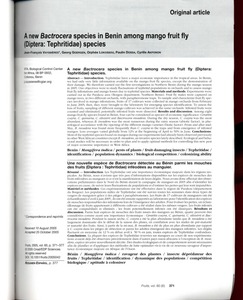| dc.contributor.author | Vayssières, J.F. |
| dc.contributor.author | Goergen, Georg E. |
| dc.contributor.author | Lokossou, O. |
| dc.contributor.author | Dossa, P. |
| dc.contributor.author | Akponon, C. |
| dc.date.accessioned | 2019-12-04T11:18:55Z |
| dc.date.available | 2019-12-04T11:18:55Z |
| dc.date.issued | 2005 |
| dc.identifier.citation | Vayssières, J., Goergen, G., Lokossou, O., Dossa, P. & Akponon, C. (2005). A new Bactrocera species in Benin among mango fruit fly (Diptera: Tephritidae) species. Fruits, 60(6), 371-377. |
| dc.identifier.issn | 0248-1294 |
| dc.identifier.uri | https://hdl.handle.net/20.500.12478/3354 |
| dc.description.abstract | Tephritidae have a major economic importance in the tropical areas. In Benin, we had only very little information available on the mango fruit fly species, except the demonstration of their damage. We therefore carried out the first investigations in Northern Benin during the mango season in 2005. Our objectives were to study fluctuations of tephritid populations in orchards and to assess mango fruit fly infestations and mango losses due to tephritid species. Materials and methods. Experiments were carried out in the Parakou area (Borgou department, Northern Benin). Fruit fly males were captured on mango trees, in two different orchards, with parapheromone traps. To sample and characterize fruit fly species involved in mango infestations, fruits of 17 cultivars were collected in mango orchards from February to June 2005; then, they were brought to the laboratory for emerging species identification. To assess the loss of fruits, sampling of different mango cultivars was achieved in the same orchards. Infested fruits were counted and eliminated; potentially infested fruits were dissected. Results and discussion. Among eight mango fruit fly species found in Benin, four can be considered as species of economic significance: Ceratitis cosyra, C. quinaria, C. silvestrii and Bactrocera invadens. During the dry season, C. cosyra was the most abundant, whereas B. invadens was the most numerous during the rainy season (abiotic factor), in phenological accordance with the ripening of the different mango varieties (biotic factor). From and after mid-May, B. invadens was found more frequently than C. cosyra in the traps and from emergence of infested mangos. Loss averages varied globally from 12% at the beginning of April to 50% in June. Conclusions. Most of the tephritid species found on mangos during our experiments had already been observed previously in other West African countries except B. invadens, an invasive species lately described. Ecological and behavioral studies will be necessary in order to plan and to apply optimal methods for controlling this new pest of major economic importance in West Africa. |
| dc.language.iso | en |
| dc.subject | Mangifera Indica |
| dc.subject | Pests Of Plants |
| dc.subject | Fruit-Damaging Insects |
| dc.subject | Tephritidae |
| dc.subject | Identification |
| dc.subject | Population Dynamics |
| dc.subject | Biological Competition |
| dc.subject | Colonizing Ability |
| dc.title | A new Bactrocera species in Benin among mango fruit fly (Diptera: Tephritidae) species |
| dc.type | Journal Article |
| dc.description.version | Peer Review |
| cg.contributor.affiliation | International Institute of Tropical Agriculture |
| cg.coverage.region | Africa |
| cg.coverage.region | West Africa |
| cg.coverage.country | Benin |
| cg.authorship.types | CGIAR single centre |
| cg.iitasubject | Plant Diseases |
| cg.iitasubject | Pests Of Plants |
| cg.iitasubject | Plant Breeding |
| cg.iitasubject | Plant Ecology |
| cg.iitasubject | Plant Health |
| cg.iitasubject | Plant Production |
| cg.iitasubject | Disease Control |
| cg.iitasubject | Livelihoods |
| cg.iitasubject | Farm Management |
| cg.accessibilitystatus | Open Access |
| local.dspaceid | 95028 |
| cg.identifier.doi | https://dx.doi.org/10.1051/fruits:2005042 |

